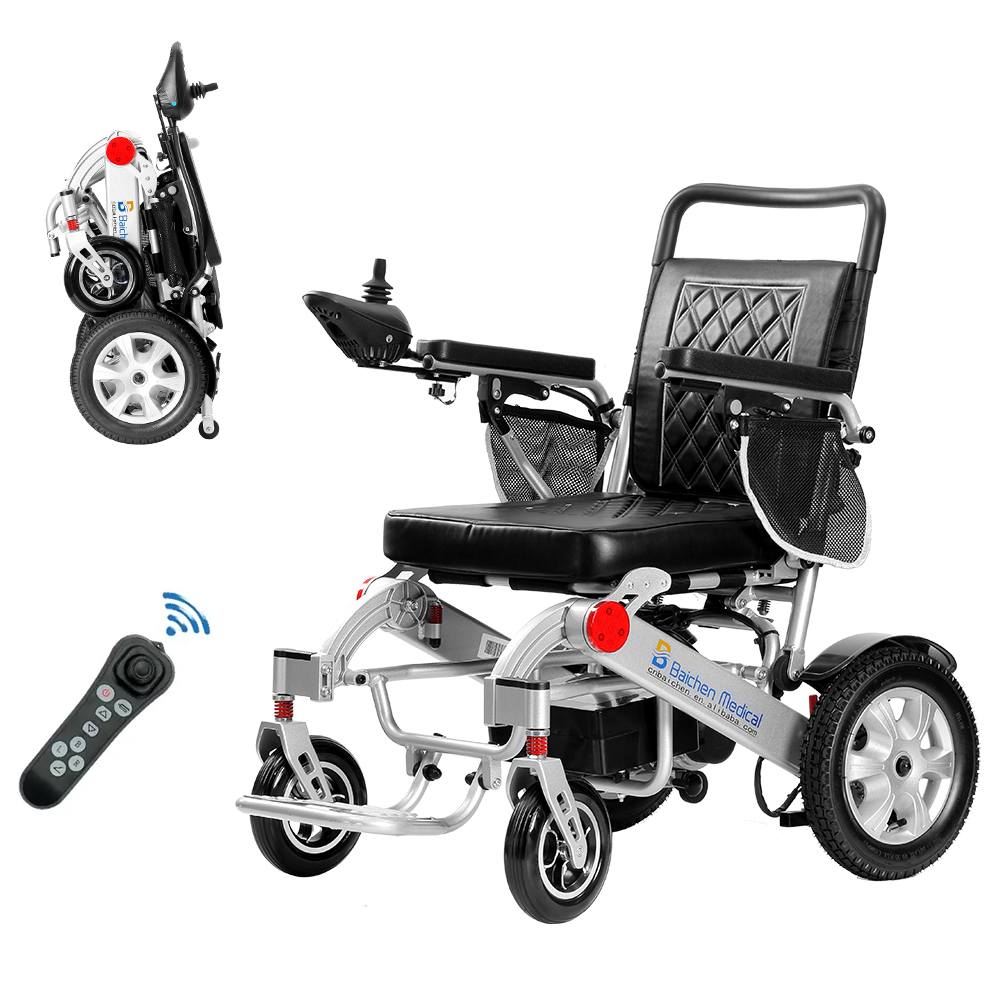
I’ve seen how Baichen’s aluminum alloy electric wheelchair transforms rehabilitation care. Its durable frame and advanced features suit both patients and caregivers. The reclining high back electric wheelchair with comf ensures comfort during recovery. As an automatic electric power wheelchair, it merges convenience with innovation, making rehabilitation more effective and stress-free.
Key Takeaways
- Baichen’s aluminum alloy electric wheelchairs are light. This makes them easy to move for patients and caregivers. It helps reduce tiredness during recovery.
- The wheelchairs have smart controls that can be adjusted. These controls improve therapy results and keep patients interested.
- Strong and rust-proof materials make them last longer. They need less fixing and save money for rehab centers.
Lightweight and Durable Aluminum Alloy Frame

Benefits of Lightweight Design for Rehabilitation
When I think about rehabilitation, mobility and ease of use come to mind. A lightweight wheelchair can make all the difference. Baichen’s aluminum alloy electric wheelchair uses advanced materials like 7005-T6 aluminum alloy. This material is not only lightweight but also incredibly strong. Patients can maneuver the wheelchair with less effort, which reduces fatigue during rehabilitation exercises. Caregivers also benefit from the lightweight design. It makes transporting and positioning the wheelchair much easier.
The reduced weight doesn’t compromise durability. In fact, the 7005-T6 aluminum alloy offers about 5% greater elastic modulus and fatigue strength compared to the commonly used 6061-T6 alloy. This means the wheelchair can withstand daily use in demanding rehabilitation environments. I’ve seen how this combination of strength and lightness improves the overall experience for both patients and caregivers.
Corrosion Resistance for Long-Term Use
Durability isn’t just about strength; it’s also about longevity. Aluminum alloy resists corrosion, making it ideal for long-term use. I’ve noticed that wheelchairs in rehabilitation settings often face exposure to moisture and cleaning agents. Baichen’s aluminum alloy electric wheelchair handles these conditions exceptionally well. The 7005-T6 alloy doesn’t require post-welding heat treatment, which simplifies manufacturing and enhances its resistance to wear and tear.
This corrosion resistance ensures the wheelchair maintains its appearance and functionality over time. Rehabilitation institutions can rely on these wheelchairs for years without worrying about frequent replacements. It’s a cost-effective solution that supports both patients and caregivers in the long run.
Advanced Electric Features for Customization
Programmable Driving Controls
I’ve always believed that customization plays a vital role in rehabilitation. Baichen’s aluminum alloy electric wheelchair offers programmable driving controls that adapt to each patient’s unique needs. These controls allow caregivers to fine-tune the wheelchair’s performance, ensuring a smoother and safer experience for patients.
What’s fascinating is how these features enhance rehabilitation outcomes. Studies show that programmable systems can significantly improve motor performance during therapy. Here’s what I’ve observed:
- Gamified robot-assisted training boosts patient engagement and recovery.
- Patients with mild impairments benefit the most from these controls.
- Metrics like higher accuracy, smoother movements, and controlled speed highlight the effectiveness of these systems.
These programmable controls make the wheelchair not just a mobility device but a tool for active rehabilitation.
Adjustable Speed and Seating Options
Comfort and adaptability are essential for long-term use. Baichen’s aluminum alloy electric wheelchair excels in both areas with its adjustable speed and seating options. Patients can modify the speed to match their comfort level, while caregivers can adjust seating positions to ensure proper posture and support.
Research backs the importance of ergonomic seating in reducing discomfort. Here’s a quick comparison of findings:
| Study | Findings |
|---|---|
| Chester et al. | Sit-stand workstations reduce neck and low back pain but may cause foot swelling. |
| O’Keeffe et al. | Dynamic chairs lead to less discomfort compared to standard chairs. |
| Annetts et al. | No chair created ideal posture; individual needs should guide chair selection. |
| Van Dieën et al. | No significant difference in muscle activity among different chair types. |
These insights emphasize the need for customizable seating. Baichen’s wheelchair addresses this by offering options tailored to individual needs, ensuring both comfort and functionality.
Enhanced Comfort for Rehabilitation Patients
Ergonomic and User-Friendly Seat Design
Comfort plays a vital role in rehabilitation, and I’ve seen how Baichen’s aluminum alloy electric wheelchair excels in this area. Its ergonomic seat design prioritizes lumbar health, which is crucial for patients with back discomfort or those aiming to prevent spinal issues. Adjustability empowers users to find their ideal seating position, improving comfort and reducing musculoskeletal risks.
User feedback has been instrumental in refining the design. Testing prototypes with diverse users uncovered ergonomic flaws and confirmed comfort benefits. Patients shared both quantitative data, such as comfort scores and usage duration, and qualitative feedback about their experiences. These insights shaped a seat design that supports long-term comfort and usability.
Support for Extended Use Without Discomfort
Rehabilitation often requires prolonged wheelchair use, and Baichen’s aluminum alloy electric wheelchair is built to meet this demand. Proper ergonomic fitting prevents discomfort during extended use, ensuring patients can focus on their recovery. High-quality materials and innovative design reduce the risk of secondary impairments associated with long-term use.
Studies highlight the importance of design in enhancing comfort. For example:
| Key Findings | Description |
|---|---|
| Ergonomic Fitting | Proper fitting of wheelchairs can prevent discomfort during extended use. |
| Quality of Wheelchair | High-quality wheelchairs reduce the risk of secondary impairments. |
| Importance of Design | Innovations focus on mechanics, movement, and user interface for comfort. |
I’ve observed how these features improve mobility and usability. Patients experience fewer wheelchair-related issues, and seating interventions become less frequent. This makes Baichen’s wheelchair a reliable choice for rehabilitation institutions.
Comprehensive Safety Features
Electromagnetic Braking System
Safety is a top priority in rehabilitation, and I’ve seen how Baichen’s aluminum alloy electric wheelchair excels in this area. Its electromagnetic braking system provides reliable stopping power, ensuring patients feel secure during use. Unlike traditional braking mechanisms, this advanced system responds instantly to user commands. It eliminates the need for manual effort, which is especially beneficial for patients with limited strength or mobility.
I’ve noticed how this feature enhances safety during therapy sessions. Patients can confidently navigate ramps, uneven surfaces, or crowded spaces without worrying about sudden movements. Caregivers also appreciate the precision of the braking system. It allows them to assist patients without compromising control. This innovation transforms the wheelchair into a dependable tool for rehabilitation, offering peace of mind to everyone involved.
Anti-Tip and Stability Enhancements
Stability is crucial for patients recovering from injuries or surgeries. Baichen’s aluminum alloy electric wheelchair incorporates anti-tip features that prevent accidents and ensure a smooth experience. These enhancements provide additional ground contact, reducing the risk of top-heavy falls. I’ve seen how they maintain control when traveling uphill or downhill, preventing backward tipping.
Here’s what makes these features stand out:
- They keep the wheelchair upright during emergencies.
- They offer reassurance to caregivers, enabling safer assistance.
- They increase stability on uneven surfaces or steep ramps.
- They provide peace of mind for both users and caregivers.
These anti-tip mechanisms make the wheelchair ideal for rehabilitation settings. Patients can focus on their recovery without worrying about safety, and caregivers can assist with confidence. Combined with the sturdy aluminum alloy frame, these features ensure long-term reliability and security.
Cost-Effective and Low Maintenance
Durable Components That Minimize Repairs
I’ve noticed how frequent repairs can disrupt rehabilitation care. Baichen’s aluminum alloy electric wheelchair solves this problem with its durable components. The high-quality materials used in its construction, including the aluminum alloy frame, resist wear and tear. This durability reduces the need for constant maintenance.
The advanced engineering behind the wheelchair ensures that every part, from the motor to the wheels, performs reliably. I’ve seen how this reliability saves time and effort for caregivers. Rehabilitation institutions benefit from fewer interruptions, allowing them to focus on patient care.
The wheelchair’s design also simplifies maintenance tasks. For example, the modular structure makes it easy to replace parts when necessary. This feature minimizes downtime and ensures the wheelchair remains functional for extended periods.
Long-Term Value for Rehabilitation Institutions
Investing in Baichen’s aluminum alloy electric wheelchair offers long-term value. Its durability and low maintenance requirements reduce operational costs over time. Rehabilitation institutions can allocate resources to other areas instead of spending on frequent repairs or replacements.
I’ve observed how the wheelchair’s longevity benefits both patients and caregivers. Patients enjoy consistent mobility support, while caregivers appreciate the reliability of the equipment. The aluminum alloy electric wheelchair becomes a cost-effective solution that enhances the overall efficiency of rehabilitation care.
Additionally, the wheelchair’s advanced features, such as programmable controls and ergonomic design, contribute to its value. These innovations improve patient outcomes, making it a worthwhile investment for institutions focused on quality care.
Baichen’s aluminum alloy electric wheelchair has redefined rehabilitation care. Its innovative design and advanced features enhance mobility and independence for patients. I’ve seen how its customizable options meet diverse needs, improving comfort and safety. Users report better quality of life, reduced discomfort, and increased social participation. These wheelchairs offer long-term value for rehabilitation institutions.
| Benefit | Description |
|---|---|
| Improved Mobility | Power wheelchair use is associated with enhanced mobility for users. |
| Social Participation | Users report increased ability to engage in social activities, such as visiting friends and family. |
| Quality of Life | Users experience an overall improvement in their quality of life due to increased independence. |
| Decreased Pain and Discomfort | Many users report a reduction in pain and discomfort when using power wheelchairs. |
Investing in these wheelchairs ensures better patient care and lasting benefits for caregivers and institutions alike.
FAQ
What makes Baichen’s aluminum alloy electric wheelchairs unique for rehabilitation?
Baichen’s wheelchairs combine lightweight aluminum alloy frames, advanced electric features, and ergonomic designs. These innovations improve mobility, comfort, and safety for patients during recovery.
How do the programmable driving controls benefit patients?
Programmable controls adapt to individual needs. They enhance therapy outcomes by improving movement accuracy, speed control, and engagement, making rehabilitation more effective and personalized.
Are Baichen’s wheelchairs easy to maintain?
Yes, their durable components and modular design simplify maintenance. Rehabilitation institutions save time and costs while ensuring uninterrupted patient care.
Post time: Jun-11-2025

